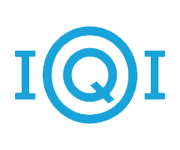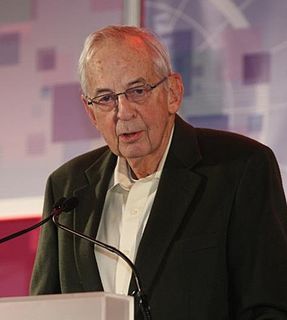
A field-programmable gate array (FPGA) is an integrated circuit designed to be configured by a customer or a designer after manufacturing – hence the term field-programmable. The FPGA configuration is generally specified using a hardware description language (HDL), similar to that used for an application-specific integrated circuit (ASIC). Circuit diagrams were previously used to specify the configuration, but this is increasingly rare due to the advent of electronic design automation tools.
In electronics and telecommunications, modulation is the process of varying one or more properties of a periodic waveform, called the carrier signal, with a separate signal called the modulation signal that typically contains information to be transmitted. For example, the modulation signal might be an audio signal representing sound from a microphone, a video signal representing moving images from a video camera, or a digital signal representing a sequence of binary digits, a bitstream from a computer. The carrier is higher in frequency than the modulation signal. In radio communication the modulated carrier is transmitted through space as a radio wave to a radio receiver. Another purpose is to transmit multiple channels of information through a single communication medium, using frequency-division multiplexing (FDM). For example in cable television which uses FDM, many carrier signals, each modulated with a different television channel, are transported through a single cable to customers. Since each carrier occupies a different frequency, the channels do not interfere with each other. At the destination end, the carrier signal is demodulated to extract the information bearing modulation signal.
This is a timeline of quantum computing.

The MOS Technology 6581/8580 SID is the built-in programmable sound generator chip of Commodore's CBM-II, Commodore 64, Commodore 128 and Commodore MAX Machine home computers. It was one of the first sound chips of its kind to be included in a home computer prior to the digital sound revolution.
This is an index of articles relating to electronics and electricity or natural electricity and things that run on electricity and things that use or conduct electricity.
Quantum optics is a branch of atomic, molecular, and optical physics dealing with how individual quanta of light, known as photons, interact with atoms and molecules. It includes the study of the particle-like properties of photons. Photons have been used to test many of the counter-intuitive predictions of quantum mechanics, such as entanglement and teleportation, and are a useful resource for quantum information processing.

Electromagnetically induced transparency (EIT) is a coherent optical nonlinearity which renders a medium transparent within a narrow spectral range around an absorption line. Extreme dispersion is also created within this transparency "window" which leads to "slow light", described below. It is in essence a quantum interference effect that permits the propagation of light through an otherwise opaque atomic medium.

A trapped ion quantum computer is one proposed approach to a large-scale quantum computer. Ions, or charged atomic particles, can be confined and suspended in free space using electromagnetic fields. Qubits are stored in stable electronic states of each ion, and quantum information can be transferred through the collective quantized motion of the ions in a shared trap. Lasers are applied to induce coupling between the qubit states or coupling between the internal qubit states and the external motional states.
The KORG Poly-61(PS-61) is an analogue programmable polyphonic synthesizer released by Korg in 1982, as a successor to the Polysix. It was notable for being Korg's first largely "knobless" synthesizer - featuring a push-button interface for programming, dispensing with the Polysix's knobs and switches. The Poly-61 also uses digitally controlled analog oscillators or DCO's, in place of the Polysix' VCOs. The Poly-61 also boasted double the amount of patch memory, but did not feature its predecessor's on board effects.

Rainer Blatt is a German-Austrian experimental physicist. His research centres on the areas of quantum optics and quantum information. He and his team performed one of the first experiments to teleport atoms, the other was done at NIST in Boulder Colorado. The reports of both groups appeared back-to-back in Nature.

Peter Zoller is a theoretical physicist from Austria. He is Professor at the University of Innsbruck and works on quantum optics and quantum information and is best known for his pioneering research on quantum computing and quantum communication and for bridging quantum optics and solid state physics.

The Institute for Quantum Optics and Quantum Information (IQOQI) is a member institute of the Austrian Academy of Sciences and was founded in November 2003, to create an Austrian research center for the newly developing fields of theoretical and experimental quantum optics and quantum information.

David Jeffrey Wineland is an American Nobel-laureate physicist at the National Institute of Standards and Technology (NIST) physics laboratory. His work has included advances in optics, specifically laser-cooling trapped ions and using ions for quantum-computing operations. He was awarded the 2012 Nobel Prize in Physics, jointly with Serge Haroche, for "ground-breaking experimental methods that enable measuring and manipulation of individual quantum systems".

A digital signal is a signal that represents data as a sequence of discrete values; at any given time it can only take on, at most, one of a finite number of values. This contrasts with an analog signal, which represents continuous values; at any given time it represents a real number within a continuous range of values.

James Power Gordon was an American physicist known for his work in the fields of optics and quantum electronics. His contributions include the design, analysis and construction of the first maser in 1954 as a doctoral student at Columbia University under the supervision of C. H. Townes, development of the quantal equivalent of Shannon's information capacity formula in 1962, development of the theory for the diffusion of atoms in an optical trap in 1980, and the discovery of what is now known as the Gordon-Haus effect in soliton transmission, together with H. A. Haus in 1986. Gordon was a member of the National Academy of Engineering and the National Academy of Sciences.

Stephen Ernest Harris is an American physicist known for his contributions to electromagnetically induced transparency (EIT), modulation of single photons, and x-ray emission.
The John Stewart Bell Prize for Research on Fundamental Issues in Quantum Mechanics and their Applications was established in 2009, funded and managed by the University of Toronto, Centre for Quantum Information & Quantum Control (CQIQC). It is awarded every odd-numbered year, for significant contributions relating to the foundations of quantum mechanics and to the applications of these principles – this covers, but is not limited to, quantum information theory, quantum computation, quantum foundations, quantum cryptography, and quantum control. The selection committee has included Gilles Brassard, Peter Zoller, Alain Aspect, John Preskill, and Juan Ignacio Cirac Sasturain, in addition to previous winners Sandu Popescu, Michel Devoret, and Nicolas Gisin.
The Cirac–Zoller controlled-NOT gate is an implementation of the controlled-NOT (CNOT) quantum logic gate using cold trapped ions that was proposed by Ignacio Cirac and Peter Zoller and represents the central ingredient of the Cirac–Zoller proposal for a trapped-ion quantum computer. The key idea of the Cirac–Zoller proposal is to mediate the interaction between the two qubits through the joint motion of the complete chain of trapped ions.
The I. I. Rabi Prize in Atomic, Molecular, and Optical Physics is given by the American Physical Society to recognize outstanding work by mid-career researchers in the field of atomic, molecular, and optical physics. The award was endowed in 1989 in honor of the physicist I. I. Rabi and has been awarded biannually since 1991.
Andrew Marc Weiner OSA NAE NAI is an American electrical engineer, educator and researcher known for contributions to the fields of ultrafast optics and optical signal processing. He is the Scifres Family Distinguished Professor of Electrical and Computer Engineering at Purdue University.









